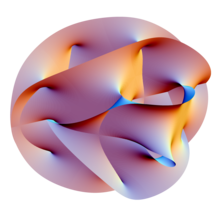Przestrzeń Calabiego-Yau
| Ten artykuł od 2012-02 wymaga zweryfikowania podanych informacji. |
Przestrzenie (lub kształty) Calabiego-Yau są rodzajem rozmaitości topologicznej, która odgrywa rolę w niektórych działach matematyki (takich jak geometria algebraiczna) oraz w fizyce. Dla przykładu teoria strun przewiduje istnienie dodatkowych wymiarów czasoprzestrzennych "zwiniętych" do postaci sześciowymiarowej przestrzeni Calabiego-Yau o wielkości długości Plancka.
Nazwę nadano na cześć dwóch matematyków, Eugenio Calabiego z Uniwersytetu Pensylwanii i Shing-Tunga Yau z Uniwersytetu Harvarda, których badania w ogromnym stopniu przyczyniły się do zrozumienia tych przestrzeni.
Media użyte na tej stronie
Autor: Lunch, Licencja: CC BY-SA 2.5
This image is a somewhat fair reconstruction of an image of the Calabi–Yau manifold that appears as a figure in the paper:
- Leonard Susskind (November 2003). "Superstrings (Features: November 2003)". Physics World 16 (11). Retrieved on 2007-07-24.
I created this image myself to replace File:Calabi-Yau.jpeg (an illicit copy of the original). To recreate the image's likeness without copying the image, I used the description on the home page of Prof. Andrew Hanson of the computer science department at the University of Indiana, and the procedure he provides in the paper:
- A.J. Hanson (November/December 1994). "A construction for computer visualization of certain complex curves". Notices of the Amer.Math.Soc. 41 (9): 1156-1163.

